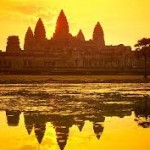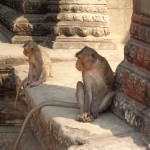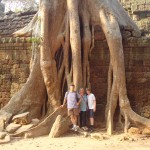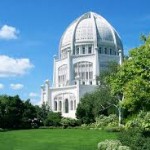Once or twice a year in my childhood, our tiny Baptist Church’s congregation would join the Presbyterians up the street. They had “Reverend Mac”, a wryly smiling minister who acted Noel Coward and Charles Dickens on the side, made jokes during sermons, and never complained about our footballs and baseballs bouncing on to his front lawn. We had a tightly-wound young fundamentalist who’d have been shocked to know of my Mum’s bridge club, cards being the devil’s playthings. Coming from our plain, cramped sanctuary, the
Presbyterians looked rich and their church seemed a soaring, grand and holy place. It had the highest bell tower in our little town, and in early adolescence I took to sneaky climbs inside the steeple that led to a view of houses, river, ball diamonds, trees, and the farmland beyond them. I’ve found holiness in forests and fields, in looking out over water, in song and in word, even sometimes in the steady rhythm of running or flinging a ball toward its home. I’ve loved, too, architectural prayers: shrines, cathedrals, temples, any place built to honour and inspire loftiness of mind, an enlarging of spirit. (Sometimes, even a gymnasium will do.)
In China, such places have been hard to come by. Before we leave, I hope we’ll get to one of the sacred mountains, but even those sound discouraging, given the masses of people that visit with little that I recognize as reverence; small-town Canuck that I am, I still equate spirituality with solitude, quiet, elevated language and, where possible, green-ness and sky. However, our teaching of English in Dalian does qualify us for more than visas, salaries, and our small service to the torrential societal change in our temporary Chinese home. As we beef up our world citizenship credentials, we also have the luxury of south Asian travel that we couldn’t have managed from Canada.
When the world’s largest human migration – the Chinese returning to their home towns for Spring Festival – occurs, we get six weeks to go exploring. Such luck! We keep coming back to Thailand, where Buddhist temples have been impressive (as much for their sheer numbers as anything else) though often disappointingly commercial. Few people seem to actually worship in them. Bicycling down dirt roads, or visiting a natural sanctuary for elephants rescued from lonely exploitation, were much more spiritual pursuits for me. This year, it has been Thailand and Cambodia. First came a meditation boot-camp about five hours north of Bangkok, a gruelling ten days to reflect and withdraw, trying to build some skill in this practice that I’ve long thought essential but about which I knew little. Technique was gained, thoughts thought, plans made, attachments weakened, perspective altered, at times painfully. Next came an amazing and unsettling kind of cultural pilgrimage, to Cambodia’s astounding collection of medieval temple and palace complexes, the best known of which is Angkor Wat.
I’m still unsure about my dive into the deep end of Buddhist meditation, but if you’re lucky enough to be able to see Cambodia’s stony contributions to world culture (along with thousands of other fortunate human beings posing for cool photos and buying memories), I recommend it highly. The history of Angkor Wat and its brother and sister monuments is astonishing, incredible, and I have continued to read and think about it. What I hadn’t realized before study, though it makes eminent sense with even a scrap of thought, is that

This is a pro’s view of sunset at Angkor Wat, not our rather grey but noble attempt at capturing the dawn.
the ancient Khmer empire’s capital area had dozens of temples that created both the technological savvy, and the monomaniacal one-upsmanship, that compelled King Suryavarman II to build the best-preserved and most ambitious of the tributes to gods and kings that dot the land near Siem Reap, Cambodia. It has stood, more or less, since the 12th century, first as a Hindu temple complex and later as a Buddhist centre.
We observed sunrise at Angkor Wat along with a few thousand friends (plus bands of eager souvenir sellers and caffeine jockeys), while our tribal sunset vigil had been from a high perch near the top of a nearby, slightly older temple site called Pre Rup. You just can’t ruin a patient watching of the sun’s rise or disappearance — well, unless you’re obsessed by selfies and other smart distraction devices. I wasn’t. I imagined the thousands watching the slow rise of light over Angkor Wat in prayerful, meditative states, which was pleasant and not awfully difficult to do. (Mind you, I did grin at the streams of tourists walking back towards food and transport 45 minutes into the dawning, apparently having forgotten that the actual sunrise was still to come. Many came racing back as the red ball appeared, in eager surprise. Or something.)
Mr. Vanna, an excellent guide, explained the construction and the bas-relief carvings of that huge pile of rock, and often steered us free of the most tourist-jammed areas. We
communed with temple monkeys, and had a bag of almonds snatched by the alpha male. We toured Angkor Thom, likely the world’s largest city eight centuries ago, the capital complex of a more benevolent Buddhist king, Jayavarman VII — and the Bayon temple at its heart. Ta Prohm, unfortunately best known to many as the site where the terrible Tomb Raiders movie was shot, was my favourite spot. There, seedling trees that sprouted on rooftops have taken over the temples, sending tendrils that became massive root-stalks along walls and into the earth. The jungle has reclaimed the work of men, and modern restorers don’t even try to evict the giant squatters in these houses of stone, and just as well: not only are the trees powerfully reverent themselves, but in many places they hold the buildings
together. All of these were wonderful places to meditate upon human hubris, the power of faith, the impermanence of life, and the “hope that springs eternal in the human breast”.
We then took a bumpy and indirect bus trip to Battambang, away from the mass of tourists and their brick-and-tile play places, through the obvious poverty of the average Cambodian life to a small city called Battambang. There, in a region that knew the worst of the Cambodian civil war and the Khmer Rouge reign of error and destruction and fear, many small miracles are happening as peace gets its balance. One that I’d heard of was the remarkable growth in educational capacity and community service of a once-tiny Baha’i community; we had read that Battambang was one of the outstanding centres of the Faith’s social action in the world. I’ve been to the Baha’i House of Worship near Chicago, the nine-sided temple of peace and unity built as North America’s first, and still only, such a spiritual dawning-
place. It’s amazing, peaceful, lofty, and nobody tries to sell you anything. Battambang will be among the first Baha’i communities in the world to build a local House of Worship; at present, there is a “mother temple” on each continent. I’d never heard of Battambang, but since we were so close, as somebody with a fascinated investment in what the Baha’is are trying to accomplish in the world, I wanted to see what this might look like. We attended a small gathering in the city, where it was explained to us that the bulk of the believers, and the most notable social action ventures, were in the surrounding villages and countryside. We were unsurprised to be warmly welcomed.
On our second day in the area, we had typical tourist plans, typical at least for this part of the country. We rode a tiny flatcar of the “bamboo train” that locals had rigged to allow some transportation during the worst of the war years. We went to see caves. One was home to millions of bats, which left their dark refuge en masse at sunset in an astonishingly long procession. Human jaws hung open in incredulity. The other was more sobering, a “killing cave” near one of the few modern Buddhist temples not destroyed during the murderous Khmer Rouge era, a time not far past that so grievously battered this struggling country from the 1970s on (that is, immediately after the American secret bombing of Cambodia ended). Nobody knows how many lives were thrown away down that dark and rocky hole. Human skulls and jawbones gave silent witness to the price of ideology, disunity and hate.
Yet, back in Thailand with our holiday travel coming to an end, it isn’t the history, ancient or recent, that has most gripped this middle-aged visitor. Near Battambang, I was moved, above all, by an open field. Our tuk-tuk driver had never been asked to go down that road before, but armed with a crude map, off we went, bouncing and careening down tracks of reddish dirt. We saw modest blue signs that labelled small roadside buildings as belonging to the Baha’i community, no doubt for its core activities of devotion and study, and the nurturing guidance of children and youth. We saw dust and mango trees, earthen floors and tin roofs. A man on a motorbike stopped us, spoke briefly in Khmer to the driver, smiled and gave us a warm greeting. He’d been told that a foreign family wanted to see the site of the future Baha’i temple, and come looking.
We followed the smiling man. His English wasn’t superb, but it was enough: this was the place. About 200 metres deep, about a kilometre wide, a field of harvested rice paddies and calmly ruminant cattle marked the place where Cambodians would raise a nine-doored architectural summons to unity, to peace, and to the progress of their region towards an ever-advancing, spiritually based civilization. Can you imagine? Eventually, all will be served by temple-surrounding institutions of health care, education and cultural improvement, because this is how Baha’i worship works. In a country that has suffered some of the most vivid symptoms of the ills plaguing humanity, whose economic future appears pinned to the hunger of foreign tourists to visit sites of ancient devotion, the most hopeful, the most real place of all, for me, was this tree-spotted lowland. The vision of a prayerful refuge-to-be is something quite different than all of Cambodia’s crumbling monuments — astounding as they are — to the faith and the pride of ancient kings. This is a vision of a future that Battambang, this obscure and vital city, is teaching us to see.






Thrilled to see this little spot of earth now and imagine what it will be very soon. Thanks so much for sharing. I will most certainly share this with the Baha’i friends in Wilmette.
From the tiny Baptist Church of your childhood, to the largest annual human migration in the world which swept you on to the Ancient Khmer civilization’s world heritage site one dawn, past crumbling and violated religious temples in the countryside and finally to a Vision of a beautiful future in a field of cows in rural Battambang!
Lovely indeed..
Inspiring!